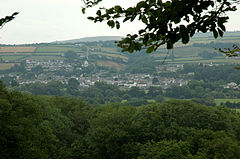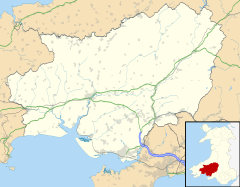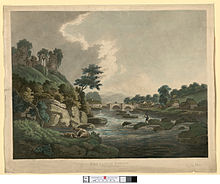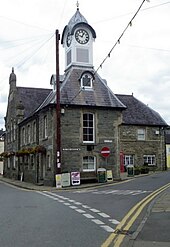| Revision as of 20:39, 16 April 2015 editRedrose64 (talk | contribs)Autopatrolled, Administrators273,059 edits →top: add |community_wales=← Previous edit | Latest revision as of 16:36, 13 November 2024 edit undo78.150.60.127 (talk) →Demography: Changed the name of the school in Llandysul. Ysgol Bro Teifi has replaced Ysgol Dyffryn Teifi as the Welsh medium school in Llandysul | ||
| (146 intermediate revisions by 60 users not shown) | |||
| Line 1: | Line 1: | ||
| {{Short description|Town in West Wales}} | |||
| {{Infobox UK place | |||
| {{Use British English|date=January 2021}} | |||
| |country = Wales | |||
| {{Use dmy dates|date=January 2021}} | |||
| |welsh_name=Castellnewydd Emlyn | |||
| {{Infobox UK place | |||
| |constituency_welsh_assembly= ] | |||
| |country = Wales | |||
| |official_name= Newcastle Emlyn | |||
| |welsh_name = Castellnewydd Emlyn | |||
| |latitude= 52.04 | |||
| |constituency_welsh_assembly = ] | |||
| |longitude= -4.47 | |||
| | |
|official_name = Newcastle Emlyn | ||
| |coordinates = {{coord|52.04|-4.47|display=inline,title}} | |||
| |unitary_wales= ] | |||
| |community_wales = Newcastle Emlyn | |||
| |lieutenancy_wales= ] | |||
| |unitary_wales = ] | |||
| |constituency_westminster= ] | |||
| |lieutenancy_wales = ] | |||
| |post_town= NEWCASTLE EMLYN | |||
| |constituency_westminster = ] | |||
| |postcode_district = SA38 | |||
| |post_town = NEWCASTLE EMLYN | |||
| |postcode_area= SA | |||
| |postcode_district = SA38 | |||
| |dial_code= 01239 | |||
| |postcode_area = SA | |||
| |os_grid_reference= SN305405 | |||
| |dial_code = 01239 | |||
| | population = 1184 | |||
| |os_grid_reference = SN305405 | |||
| | population_ref = (2011)<ref>{{cite web|url=https://neighbourhood.statistics.gov.uk/dissemination/LeadKeyFigures.do?a=7&b=11126906&c=SA38+9DN&d=16&e=62&g=6492085&i=1001x1003x1032x1004&m=0&r=0&s=1428948140297&enc=1|title=Community population 2011 |accessdate=13 April 2015}}</ref> | |||
| |population = 1184 | |||
| |static_image=] | |||
| |population_ref = (2011)<ref>{{Cite web |url=https://neighbourhood.statistics.gov.uk/dissemination/LeadKeyFigures.do?a=7&b=11126906&c=SA38+9DN&d=16&e=62&g=6492085&i=1001x1003x1032x1004&m=0&r=0&s=1428948140297&enc=1 |title=Community population 2011 |access-date=13 April 2015}}</ref> | |||
| |static_image_caption= View across the Teifi valley towards Newcastle Emlyn | |||
| |static_image_name = Newcastle Emlyn-panorama.jpg | |||
| }} | |||
| |static_image_caption = View across the Teifi valley towards Newcastle Emlyn | |||
| |website = {{url|https://www.newcastleemlyntowncouncil.co.uk|newcastleemlyntowncouncil.co.uk}} | |||
| | module= ]<br />Map of the community | |||
| }} | |||
| '''Newcastle Emlyn''' ( |
'''Newcastle Emlyn''' ({{langx|cy|Castellnewydd Emlyn}}) is a town on the ], straddling the counties of ] and ] in West ]. It is also a ] entirely within Carmarthenshire, bordered by those of ] and ], also in Carmarthenshire, and by ] in ]. ] is the part of town on the Ceredigion side of the River Teifi. It was formerly called Trefhedyn and was an ancient Welsh ] in its own right. The area including Adpar had a population of 1,883 according to the 2011 census.<ref>{{NOMIS2011 |id=W37000324 |title=Newcastle Emlyn built-up |access-date=6 May 2019}}</ref> | ||
| ] is the part of the town that lies on the Ceredigion side of the River Teifi. It was formerly called Trefhedyn and was an ancient Welsh ] in its own right. | |||
| ==History== | ==History== | ||
| ] | |||
| ] | ] | ||
| The town takes its name from the ] of ] |
The town takes its name from the ] of ], an administrative district in medieval ].<ref>Richards, Melville, ''Welsh Administrative and Territorial Units'', UoW Press, 1969, p 268</ref> | ||
| ], was first mentioned in ] in 1215, when it was seized by ] ({{langx|cy|Llywelyn Fawr}}).<ref>''The Welsh Academy Encyclopaedia of Wales''. John Davies, ], Menna Baines and Peredur Lynch (2008) pg609 {{ISBN|978-0-7083-1953-6}}</ref> It was captured by the Welsh during the revolt of 1287–1288 and also by ] in 1403.<ref>{{cite book|url= https://books.google.com/books?id=8XGoAwAAQBAJ&pg=PP139 |title=Owain Glyndwr The Story of the Last Prince of Wales|first= Terry |last=Breverton |year=2009|publisher=Amberley Publishing|isbn=978-1445608761}}</ref> | |||
| The population in 1841 was under 1,000.<ref>''The National Cyclopaedia of Useful Knowledge'', Vol. III, London, 1847, Charles Knight, p. 1,013.</ref> ] was completed in 1892.<ref>{{NHAW|desc=Town Hall & Market Buildings |num=9706|access-date=7 September 2023}}</ref> | |||
| Newcastle Emlyn has a ] and ], Ysgol Gyfun Emlyn. Attractions around the area include an ], the Attic Theatre company, the ]. The ] is nearby, although the town has not had a passenger train service since 1952. | |||
| The ] is nearby, although the town has not had a passenger train service since 1952.<ref>{{cite web |last1=Catford |first1=Nic |title=Newcastle Emlyn |url=http://www.disused-stations.org.uk/n/newcastle_emlyn/ |website=Disused Stations |access-date=26 April 2020}}</ref> | |||
| ==Economy== | |||
| Unlike many small ] towns across ], Newcastle Emlyn has managed to maintain a wide range of local services, based mainly on small family businesses.{{CN|date=March 2015}} | |||
| Newcastle Emlyn hosted the ] in 1981.<ref>{{cite book|url= https://books.google.com/books?id=-j0ro22GZU8C |title=Reference Wales|first=John|last=May|publisher=University of Wales Press|year=1994|isbn=978-0708312346|page=81}}</ref> | |||
| In 1932, the former ] ] was reopened by ] to make ]. After new parent ] decided to sell-off its non-milk related dairies, it was then bought by the ] in 1979, and closed again in 1983.<ref name="Dairies in Ceredigion">{{cite web|url=http://pilgrim.ceredigion.gov.uk/index.cfm?articleid=1961|title=Dairies in Ceredigion|publisher=Ceredigion.gov.uk|accessdate=2012-01-28}}</ref> Reopened by ], it today manufactures ] cheese using locally sourced dairy produce, and is the town's largest employer. | |||
| ==Governance== | |||
| ]]] | |||
| There are two tiers of local government covering Newcastle Emlyn, at ] (town) and ] level: Newcastle Emlyn Town Council and ]. The town council meets at ] on Market Square.<ref>{{cite web |title=Newcastle Emlyn Town Council |url=https://www.newcastleemlyntowncouncil.co.uk/nceTownCouncil/council-information |access-date=18 January 2024}}</ref> | |||
| Newcastle Emlyn was historically part of the ] of Cenarth. When elected parish and district councils were established in 1894, Cenarth was given a parish council and included in the ]. In 1897 part of the parish on Cenarth was converted into an ] called Newcastle Emlyn.<ref>{{cite book |title=Annual Report of the Local Government Board |date=1897 |page=271 |url=https://books.google.com/books?id=WwpJAQAAMAAJ&pg=271 |access-date=18 January 2024}}</ref> Newcastle Emlyn Urban District was abolished in 1974, with its area becoming a community instead. District-level functions passed to ], which was in turn replaced by Carmarthenshire County Council in 1996.<ref>]</ref><ref>]</ref> | |||
| ==Economy== | |||
| In 1932, the former ] ] was reopened by ] to make ]. After a new parent firm, ], decided to sell off its non-milk related dairies, it was bought by the ] in 1979, but closed again in 1983.<ref name="Dairies in Ceredigion">{{Cite web |url=http://pilgrim.ceredigion.gov.uk/index.cfm?articleid=1961 |title=Dairies in Ceredigion |publisher=Ceredigion.gov.uk |access-date=2012-01-28}}</ref> | |||
| ==Transport== | ==Transport== | ||
| In 1895, the ] of the ] reached ].<ref name=Disused>{{ |
In 1895, the ] of the ] (GWR) reached ].<ref name=Disused>{{Cite web |url=http://www.disused-stations.org.uk/n/newcastle_emlyn/index.shtml |title=Newcastle Emlyn railway station |publisher=disused-stations.org.uk |access-date=2012-01-28}}</ref> Originally conceived as a 7 ft, ¼ inch ] line between ] and ] by the ], it was absorbed into the GWR, which developed the line only as far as Newcastle Emlyn. | ||
| Passenger services ceased in 1952, but goods services due in part to ] services to the |
Passenger services ceased in 1952, but goods services continued until 1973, due in part to ] services to the cheese-producing creamery.<ref name="Dairies in Ceredigion"/> After the goods service ceased, the lines were removed and the station demolished.<ref>{{Cite web |url=http://www.teifivalleyrailway.com/About.htm |title=About the Railway|publisher=Teifi Valley Railway |access-date=2008-02-09 |archive-url=https://web.archive.org/web/20071218004351/http://www.teifivalleyrailway.com/About.htm |archive-date=2007-12-18}}</ref> | ||
| ==Demography== | ==Demography== | ||
| According to the ] Newcastle Emlyn had a population of 1,883, including Adpar on the Ceredigion side of the River Teifi. A 2017 population estimate put it at 1,888, of whom 52 per cent were female and 48 per cent male, with 379 aged 0–17 years, 979 aged 18–64, and 530 aged over 65. | |||
| According to the 1901 Census, 95.5% of Newcastle Emlyn Urban District's 820 residents aged 3 or over spoke Welsh, and up until the 1960s, 90% of the town's population remained Welsh-speaking. According to the ], 69% of the 950 people who lived within Newcastle Emlyn spoke fluent ], although the percentage fell rapidly in the following decade to 53.7% as the town's population increased to 1,138 residents aged 3 or over by 2011. | |||
| The 2001 UK census had 69 per cent of the 950 people then living in Newcastle Emlyn speaking fluent ], although the proportion fell in the next decade to 54 per cent, as the town population increased to 1,138 aged 3 or over by 2011.<ref>{{Cite web |title=2011 Census results by Community |url=http://www.comisiynyddygymraeg.cymru/English/Assistance/Dataandstatisitcs/Pages/2011CensusresultsbyCommunity.aspx |publisher=] |year=2015 |access-date=12 August 2015 }}{{dead link |date=November 2017 |bot=InternetArchiveBot |fix-attempted=yes}}</ref> The drop in Welsh usage in Newcastle Emlyn between 2001 and 2011 was among the biggest in Wales, though not uncommon across Ceredigion and Carmarthenshire. | |||
| 64.8% of the town's residents were born in Wales. | |||
| The latest ] inspection report in 2012 on the town's English-medium secondary school notes that only 12 per cent of pupils came from homes where Welsh is spoken, with 31 per cent considered fluent in the language. Parents have the option of sending their children to a designated Welsh-medium secondary school, Ysgol Bro Teifi in Llandysul, Ceredigion. Only 64.8 per cent of the town's residents were born in Wales. | |||
| Taken together with Adpar on the Ceredigion side of the river Teifi, the area's total population was 1,883 people according to the ]. | |||
| The town has a dual-language primary school,<ref></ref> and also a pre-school establishment known as Meithrinfa Teifi Tots Nursery.<ref></ref> | |||
| ==Sports== | |||
| Newcastle Emlyn has both football and rugby teams. ] are members of the ] and ] are members of the ]. | |||
| ==Education and culture== | |||
| ==The legend of Emlyn Wyvern== | |||
| Newcastle Emlyn has a ], ]. The town's attractions include an ], the Attic Theatre company and the ].<ref>{{cite news|url=http://news.bbc.co.uk/1/hi/wales/mid/3571241.stm |publisher=BBC News |title= National Woollen museum re-opens|access-date=7 September 2023}}</ref> | |||
| ] | |||
| The story of ''Gwiber Castell Newydd Emlyn'' (the Wyvern of Newcastle Emlyn) is a local tradition. It tells how, on one of the fair days when the town was full of people, a fierce winged viper called a ] breathing fire and smoke, alighted on the castle walls and, having cast threatening glances around, settled down to sleep. Its appearance on the castle at first brought terror to all but, after the fear had died down, a few brave townsfolk sought to destroy the fearsome monster. | |||
| ==Sports== | |||
| A soldier devised the plan of wading the river Teifi to a point of vantage on the castle side and letting a red cloak float in the river and shooting the gwiber in a vulnerable under-part of the body. The creature, so violently startled from its slumber, caught sight of the cloak and fell upon it with horrible shrieks and tore it to shreds. The assailant meanwhile, escaped to a place of safety. | |||
| Newcastle Emlyn has association football and rugby teams. ] are members of the ] and ] of the ]. | |||
| ==Legend== | |||
| The wyvern, in its death throes, turned onto its back and floated down the river. From its wound gushed forth a most loathsome venom which polluted the water and killed all the fish. The legend tells of the great joy of the townsfolk when they saw the monster dead.<ref>''Newcastle Emlyn Millennium Edition Historical Notes About Our Town'' pp10, Pamela Jenkins (1999) Castle Publications</ref> | |||
| ] | |||
| A legend of the ''Wyvern of Newcastle Emlyn'' (Gwiber Castell Newydd Emlyn) tells how on a fair day when the town was full, a winged ] breathing fire and smoke landed on the castle walls, stared threateningly, then settled down to sleep. The general terror gave way to an effort by a few townsfolk to destroy it. A soldier waded the Teifi to a vantage point on the castle side and released a red cloak into the river. The creature, suddenly woken, caught sight of the cloak, fell on it with shrieks and tore it to shreds, but was shot in its vulnerable underparts. The assailant escaped to safety. The dying wyvern turned over and floated down the river, its wound gushing venom that fouled the water and killed all the fish. There was joy at the monster's death.<ref>''Newcastle Emlyn Millennium Edition Historical Notes About Our Town'' p. 10, Pamela Jenkins (1999) Castle Publications.</ref> | |||
| ==Twin town== | ==Twin town== | ||
| Newcastle Emlyn is ] with ] in ], France. | |||
| == |
==Notable people== | ||
| {{unreferenced section|date=March 2023}} | |||
| People associated with Newcastle Emlyn include: | |||
| In birth order: | |||
| * ] (1836–96), Congregational minister | |||
| *] (1836–1896), ] minister | |||
| * ] (1923–84), jazz ] | |||
| *] (1836–1908), novelist | |||
| * ] (1843–1905), founder of department store | |||
| *] (1843–1905), founder of ] | |||
| * ] (1836–1908), novelist | |||
| *] (1872–1940), Liberal Party politician and hotel proprietor | |||
| * Dr. ], a prominent evangelical leader in Great Britain, is buried in the town. | |||
| *] (1899–1981), ] leader, buried in the town | |||
| * ] (1990- ) Welsh Rugby Union International is a product of ] | |||
| *] (1916–1997), British painter, illustrator and educator, ] | |||
| *] (1923–1984), jazz ] | |||
| *] (1966–1989), peace campaigner at ] | |||
| *] (born 1988) Welsh rugby union international from ] | |||
| *] (born 1990), Welsh rugby union international from Newcastle Emlyn RFC | |||
| *] (born 1990), Welsh rugby union and British and Irish Lion international from Newcastle Emlyn RFC | |||
| == |
==References== | ||
| {{reflist}} | {{reflist}} | ||
| == |
==External links== | ||
| {{Commons category}} | |||
| {{Commonscat}} | |||
| * |
* | ||
| {{Carmarthenshire}} | {{Carmarthenshire}} | ||
| {{Communities of Carmarthenshire}} | {{Communities of Carmarthenshire}} | ||
| {{authority control}} | |||
| ] | |||
| ] | |||
| ] | ] | ||
| ] | |||
| ] | ] | ||
| ] | |||
Latest revision as of 16:36, 13 November 2024
Town in West WalesHuman settlement in Wales
Newcastle Emlyn
| |
|---|---|
 View across the Teifi valley towards Newcastle Emlyn View across the Teifi valley towards Newcastle Emlyn | |
 | |
| Population | 1,184 (2011) |
| OS grid reference | SN305405 |
| Community |
|
| Principal area | |
| Preserved county | |
| Country | Wales |
| Sovereign state | United Kingdom |
| Post town | NEWCASTLE EMLYN |
| Postcode district | SA38 |
| Dialling code | 01239 |
| Police | Dyfed-Powys |
| Fire | Mid and West Wales |
| Ambulance | Welsh |
| UK Parliament | |
| Senedd Cymru – Welsh Parliament | |
| Website | newcastleemlyntowncouncil.co.uk |
52°02′N 4°28′W / 52.04°N 4.47°W / 52.04; -4.47  Map of the community | |
Newcastle Emlyn (Welsh: Castellnewydd Emlyn) is a town on the River Teifi, straddling the counties of Ceredigion and Carmarthenshire in West Wales. It is also a community entirely within Carmarthenshire, bordered by those of Llangeler and Cenarth, also in Carmarthenshire, and by Llandyfriog in Ceredigion. Adpar is the part of town on the Ceredigion side of the River Teifi. It was formerly called Trefhedyn and was an ancient Welsh borough in its own right. The area including Adpar had a population of 1,883 according to the 2011 census.
History


The town takes its name from the cantref of Emlyn, an administrative district in medieval Dyfed.
Newcastle Emlyn Castle, was first mentioned in Brut y Tywysogion in 1215, when it was seized by Llewelyn the Great (Welsh: Llywelyn Fawr). It was captured by the Welsh during the revolt of 1287–1288 and also by Owain Glyndŵr in 1403.
The population in 1841 was under 1,000. Cawdor Hall was completed in 1892.
The Teifi Valley Railway is nearby, although the town has not had a passenger train service since 1952.
Newcastle Emlyn hosted the Urdd National Eisteddfod in 1981.
Governance

There are two tiers of local government covering Newcastle Emlyn, at community (town) and county level: Newcastle Emlyn Town Council and Carmarthenshire County Council. The town council meets at Cawdor Hall on Market Square.
Newcastle Emlyn was historically part of the ancient parish of Cenarth. When elected parish and district councils were established in 1894, Cenarth was given a parish council and included in the Newcastle Emlyn Rural District. In 1897 part of the parish on Cenarth was converted into an urban district called Newcastle Emlyn. Newcastle Emlyn Urban District was abolished in 1974, with its area becoming a community instead. District-level functions passed to Carmarthen District Council, which was in turn replaced by Carmarthenshire County Council in 1996.
Economy
In 1932, the former Co-operative creamery was reopened by Dried Milk Products to make cheese. After a new parent firm, Unigate, decided to sell off its non-milk related dairies, it was bought by the Milk Marketing Board in 1979, but closed again in 1983.
Transport
In 1895, the Teifi Valley Railway of the Great Western Railway (GWR) reached Newcastle Emlyn railway station. Originally conceived as a 7 ft, ¼ inch broad-gauge line between Carmarthen and Cardigan by the Carmarthen and Cardigan Railway, it was absorbed into the GWR, which developed the line only as far as Newcastle Emlyn.
Passenger services ceased in 1952, but goods services continued until 1973, due in part to milk train services to the cheese-producing creamery. After the goods service ceased, the lines were removed and the station demolished.
Demography
According to the United Kingdom census 2011 Newcastle Emlyn had a population of 1,883, including Adpar on the Ceredigion side of the River Teifi. A 2017 population estimate put it at 1,888, of whom 52 per cent were female and 48 per cent male, with 379 aged 0–17 years, 979 aged 18–64, and 530 aged over 65.
The 2001 UK census had 69 per cent of the 950 people then living in Newcastle Emlyn speaking fluent Welsh, although the proportion fell in the next decade to 54 per cent, as the town population increased to 1,138 aged 3 or over by 2011. The drop in Welsh usage in Newcastle Emlyn between 2001 and 2011 was among the biggest in Wales, though not uncommon across Ceredigion and Carmarthenshire.
The latest Estyn inspection report in 2012 on the town's English-medium secondary school notes that only 12 per cent of pupils came from homes where Welsh is spoken, with 31 per cent considered fluent in the language. Parents have the option of sending their children to a designated Welsh-medium secondary school, Ysgol Bro Teifi in Llandysul, Ceredigion. Only 64.8 per cent of the town's residents were born in Wales.
The town has a dual-language primary school, and also a pre-school establishment known as Meithrinfa Teifi Tots Nursery.
Education and culture
Newcastle Emlyn has a secondary school, Ysgol Gyfun Emlyn. The town's attractions include an art gallery, the Attic Theatre company and the National Woollen Museum.
Sports
Newcastle Emlyn has association football and rugby teams. Newcastle Emlyn Football Club are members of the Football Association of Wales and Newcastle Emlyn RFC of the Welsh Rugby Union.
Legend

A legend of the Wyvern of Newcastle Emlyn (Gwiber Castell Newydd Emlyn) tells how on a fair day when the town was full, a winged wyvern breathing fire and smoke landed on the castle walls, stared threateningly, then settled down to sleep. The general terror gave way to an effort by a few townsfolk to destroy it. A soldier waded the Teifi to a vantage point on the castle side and released a red cloak into the river. The creature, suddenly woken, caught sight of the cloak, fell on it with shrieks and tore it to shreds, but was shot in its vulnerable underparts. The assailant escaped to safety. The dying wyvern turned over and floated down the river, its wound gushing venom that fouled the water and killed all the fish. There was joy at the monster's death.
Twin town
Newcastle Emlyn is twinned with Plonévez-Porzay in Brittany, France.
Notable people
| This section does not cite any sources. Please help improve this section by adding citations to reliable sources. Unsourced material may be challenged and removed. (March 2023) (Learn how and when to remove this message) |
In birth order:
- Evan Herber Evans (1836–1896), Congregational minister
- Allen Raine (1836–1908), novelist
- Peter Rees Jones (1843–1905), founder of Peter Jones department store
- Owen Picton Davies (1872–1940), Liberal Party politician and hotel proprietor
- Martyn Lloyd-Jones (1899–1981), Evangelical leader, buried in the town
- John Elwyn (1916–1997), British painter, illustrator and educator, Adpar
- Dill Jones (1923–1984), jazz stride pianist
- Helen Thomas (1966–1989), peace campaigner at Greenham Common
- Josh Turnbull (born 1988) Welsh rugby union international from Newcastle Emlyn RFC
- Scott Williams (born 1990), Welsh rugby union international from Newcastle Emlyn RFC
- Gareth Davies (born 1990), Welsh rugby union and British and Irish Lion international from Newcastle Emlyn RFC
References
- "Community population 2011". Retrieved 13 April 2015.
- UK Census (2011). "Local Area Report – Newcastle Emlyn built-up (W37000324)". Nomis. Office for National Statistics. Retrieved 6 May 2019.
- Richards, Melville, Welsh Administrative and Territorial Units, UoW Press, 1969, p 268
- The Welsh Academy Encyclopaedia of Wales. John Davies, Nigel Jenkins, Menna Baines and Peredur Lynch (2008) pg609 ISBN 978-0-7083-1953-6
- Breverton, Terry (2009). Owain Glyndwr The Story of the Last Prince of Wales. Amberley Publishing. ISBN 978-1445608761.
- The National Cyclopaedia of Useful Knowledge, Vol. III, London, 1847, Charles Knight, p. 1,013.
- Cadw. "Town Hall & Market Buildings (9706)". National Historic Assets of Wales. Retrieved 7 September 2023.
- Catford, Nic. "Newcastle Emlyn". Disused Stations. Retrieved 26 April 2020.
- May, John (1994). Reference Wales. University of Wales Press. p. 81. ISBN 978-0708312346.
- "Newcastle Emlyn Town Council". Retrieved 18 January 2024.
- Annual Report of the Local Government Board. 1897. p. 271. Retrieved 18 January 2024.
- Local Government Act 1972
- Local Government (Wales) Act 1994
- ^ "Dairies in Ceredigion". Ceredigion.gov.uk. Retrieved 28 January 2012.
- "Newcastle Emlyn railway station". disused-stations.org.uk. Retrieved 28 January 2012.
- "About the Railway". Teifi Valley Railway. Archived from the original on 18 December 2007. Retrieved 9 February 2008.
- "2011 Census results by Community". Welsh Language Commissioner. 2015. Retrieved 12 August 2015.
- School site. Retrieved 18 July 2020.
- Details. Retrieved 18 July 2020.
- "National Woollen museum re-opens". BBC News. Retrieved 7 September 2023.
- Newcastle Emlyn Millennium Edition Historical Notes About Our Town p. 10, Pamela Jenkins (1999) Castle Publications.
External links
| Carmarthenshire | |||
|---|---|---|---|
| Principal settlements |  | ||
| Towns and villages |
| ||
| Buildings and structures |
| ||
| Rivers | |||
| Topics | |||